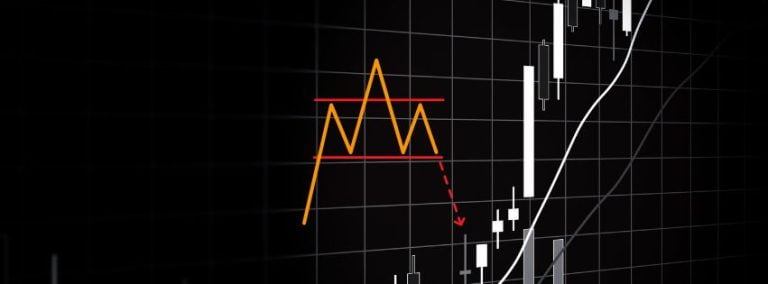As the most renowned bearish reversal chart pattern, the Head and Shoulders pattern is widely used by all types of traders, including those in stocks, futures, and Forex. This pattern helps traders identify the potential top of an uptrend, allowing them to take profits on long positions and enter short positions at an early stage.
Head and Shoulder Meaning
The Head and Shoulders pattern (H&S pattern) means a specific chart pattern in technical analysis that includes a left shoulder, a head, and a right shoulder, indicating a potential trend reversal. It is also referred to as the bearish Head and Shoulder or Head and Shoulder top, as it appears in an uptrend and signals a bearish reversal.
In the formation of the Head & Shoulders pattern, after a prolonged upward trend, profit-taking by some buyers causes a pullback. However, strong buying power quickly supports the market, leading to a return to the uptrend and reaching a new high.
As the market achieves a new high, more profit-taking orders emerge, causing a deeper pullback along with increased selling pressure. The market finds support again around the low price of the first pullback.
The rise following the 2nd pullback weakens, initiating a third fall without reaching a new high. Eventually, the market breaks below the previous low and begins a downtrend.
Head & Shoulder Pattern Rules
The Head and Shoulders pattern is easy to spot, and traders have a good chance of making profits overall by strictly following the rules below:
- Wait for prices to break below the neckline support to confirm the pattern.
- Enter the short position after confirming the neckline breakout.
- Place the stop-loss above either the neckline or the right shoulder.
- Set the target price based on the height of the entire pattern.
Head and Shoulder Neckline
The neckline of the Head and Shoulders pattern acts as a crucial support line, playing a key role in identifying and trading the pattern. At the completion of the right shoulder formation, the pattern is confirmed only when the market breaks below the neckline.
Sometimes, shortly after the neckline breakout and before the significant decline begins, the price may retest the neckline, which has now turned into a resistance line. If the market confirms resistance at the neckline, it presents a perfect opportunity to re-enter a short position.
In summary, the neckline of the head and shoulders pattern serves two key functions:
1). Confirm the pattern through neckline breakout
The H&S pattern can only be confirmed after the neckline breakout. Traders should wait for this confirmation before shorting the market.
2). Additional sell opportunity in neckline retest
While neckline retest is not an essential part of the Head and Shoulders pattern, it often provides a better selling opportunity if it occurs.
Head and Shoulder Pattern Target
Besides providing clear instructions for the entry point, one of the best aspects of the H&S pattern is its ability to offer a predictable target price. The target for the pattern can be easily calculated using the formula below:
Head and Shoulder Pattern Target = Neckline Price – (High Price in the Head – Neckline Price)
Simply put, after the neckline breakout, the market typically falls at least the height of the Head & Shoulders pattern. In many cases, the price will decline beyond this target.
For example, consider a Head and Shoulders pattern on the daily chart of gold, with a neckline price of $2,000 and a head price of $2,150.
After entering a short position following the neckline breakout, the target price is calculated as follows: 2,000 – (2,150 – 2,000) = $1,850.
Forex Head and Shoulder Example
We will use an example of a Forex Head and Shoulders pattern to demonstrate tips for identifying and trading this pattern. In the AUD/USD daily chart below, a Head and Shoulders pattern formed between December 2020 and June 2021, with a neckline price of 0.76000 and a head price of 0.80000. We will break down the trading process of this pattern into three steps.
The following chart is a typical head and shoulders pattern in Forex, being the daily chart of AUDUSD from the late 2020 to early 2021. At that time, the Australian Dollar rallied for nearly a year from its low point of 0.5500 during the Covid-19 crisis. It peaked at 0.8000 and then formed a head and shoulder pattern on the forex pair in daily chart. Below are the key details for this pattern:
Step One: Find the Support Line
When this Forex chart reached point A and found support at this level, many traders will draw a support line by connecting it to the previous low price.This line is also the supporting level turned from the resistance level of the high price in middle December.
Step Two: Identify the H&S Pattern
When the price moved to point A and started to fall after closing with a cross star, a potential H&S pattern could already be identified. At this point, many traders begin to apply the Head & Shoulders pattern rules in their strategies and treat the support line as the neckline.
Step Three: Neckline Breakout and Retest
On June 17, 2021, the AUD/USD price broke below the neckline. Many traders opened short positions after the market closed with a long negative candle. A week after the neckline breakout, the price only fell slightly below 0.75000 and rises again to point D, retesting the neckline. Once the retest was confirmed, the market fell again, prompting traders to enter extra short positions.
With the neckline price at 0.76000 and the high price at 0.80000, the target for this Head and Shoulders pattern can be calculated as 0.72000. Eventually, the AUD/USD fell to this target in approximately two months.
Failed Head and Shoulders Pattern
Compared to the double top pattern, the Head and Shoulders pattern appears less frequently due to its more complex structure. However, this does not necessarily mean it has a higher success rate. It’s common for formations resembling a H&S pattern to occur, only for the neckline breakout not to happen, leading the market to rise to a new high instead.
Below is an example from the 4-hour chart of the Dow Jones Index. The highlighted pattern exhibits all the characteristics of a H&S pattern, but the neckline did not break, resulting in a failed pattern. Therefore, to minimize the risk of encountering failed Head and Shoulders patterns, traders are encouraged to wait for confirmation of the neckline breakout.
Even if the neckline breakout occurs, the market can still reverse back up to the neckline and moved to a new high, resulting in a failed H&S pattern. Traders should adhere to Head and Shoulders pattern rules with strict risk management to minimize losses from failed patterns and maximize profits from successful ones.
Complex Head and Shoulders Pattern
In addition to the typical Head and Shoulders pattern, which includes one left shoulder and one right shoulder, there are also variants with multiple left or right shoulders, known as complex Head and Shoulders patterns.
As shown in the example, there are two right shoulders in the pattern, with their high prices typically at similar levels. This can still be considered a Head and Shoulders pattern, and the trading rules remain exactly the same.
This reminders traders that even the neckline breakout does not happen in the end of the typical right shoulder, it is still important to keep a close eye on the neckline support.
In essence, the head and shoulders pattern extends from the application of support line. After a prolonged uptrend in the market, it is natural for the price to potentially decline significantly once a key support level is breached.
Inverted Head and Shoulder Pattern
As the name suggests, the inverted Head and Shoulders pattern is literally the inverse of the Head and Shoulders pattern. It is a bullish reversal pattern occurring in a downtrend, indicating a potential end to the downward movement.
For more details on this inverted pattern, please click and read through the article below:
「How to Identify and Trade Inverted Head and Shoulder Pattern」






